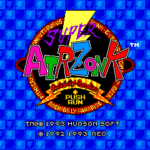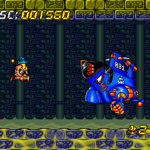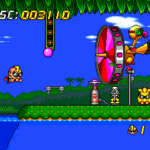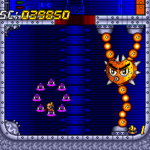Retro-Game Backlog Entry #2: Super Air Zonk
 While my memory of the two Air Zonk games is hazy, I had high hopes for the CD-based sequel. Issued in 1993, it turns out I likely never played this one and that’s a good thing. While there are a few improvements in the Super follow-up, it’s not not quite as good or as fun as the original. Had this been my introduction, I might not look back so fondly on the game series.
While my memory of the two Air Zonk games is hazy, I had high hopes for the CD-based sequel. Issued in 1993, it turns out I likely never played this one and that’s a good thing. While there are a few improvements in the Super follow-up, it’s not not quite as good or as fun as the original. Had this been my introduction, I might not look back so fondly on the game series.
On the plus side, the ludicrous difficulty of the first game is not at all matched here. The game’s music, now Red Book, of course sounds a lot better but that does not make it more memorable. I found myself irritated by most of the music in the first four selectable stages. After choosing those four, you’re presented with three more that you must go through sequentially. Those levels had much better music, worth turning the volume up for. Unfortunately, some of the game’s tinnier sound effects, like when your weapons are powered up, cut through everything making you reduce that volume rather quickly. It turns out the Japanese version featured lyrics with certain songs, something I don’t feel I missed out on. Though, I still find the Japanese name for the game/series hilarious (PC Genjin or CD Denjin in this case).


While the audio quality itself is superior, it’s hard to say much else is. Controls and the buddy system have changed a bit, but the most underwhelming thing must be the visuals. Landing a year later than the original Air Zonk, it was fair to expect bigger and better and more of everything good. But the visuals first and foremost disappoint. Those glorious 16-Bit (*cough*) graphics with the multi-layered parallax scrolling feel watered down and the stages just didn’t have the same vibrancy. In fact, Super Air Zonk doesn’t feature that same parallax which is surprising and disappointing. Stages end up looking flat despite the colorful palette. This is certainly attributed to a different developer taking the helm: the typically-consistent Hudson Soft in this case.
As for the gameplay itself, the developers clearly took inspiration from R-Type. The third level has you moving around a pre-set path which sometimes leaves you stuck at certain points or paused waiting for the stage to progress. Other portions of levels are just entirely barren, an inexplicable issue in a game like this. Initial stages also have hidden sections which are rewarding for replays, but most of the design choices felt like a step backwards. Instead of that ‘bigger and better‘ sensation you want, a lot was ‘as good or worse‘. The power-ups changed this time around, they too take inspiration from R-Type, but the result was by no means better. You could separate from your mid-stage buddy, assuming you managed to collect and save him, or have the buddy attach to you. Each had a different firing configuration, much like in Irem’s legendary shooter. However, the diversity of weapons wasn’t as interesting or as useful. A few are entirely overpowered and you better not lose them if you get them. The game is quite tough with standard weapons and these huge screen-filling attacks were perfect for when enemies surrounded you from all sides.


The eased-up difficulty of the final stages was a positive change, though some felt it was too easy. The final boss, for instance, was a
straightforward sequence of repetition, requiring no real skill outside the standard dodge-and-weave of the four forms of Emperor Sandrovich . It was, therefore, asubstantial improvement from the bullshit demands of the first entry. However, the boss rush on stage 6 was right up there with the bullshittiest moments in gaming. The ending baddie summons the bosses from the first levels of the title, one at a time. However, if you can’t beat that boss fast enough, the next arrives, and the next (presumably – you’d likely be dead by then). But don’t rest up yet…after defeating the 1-2-3-4 punch, the boss summons those assholes two more times. It’s nonsense, the bullet sponges just returning dishing out incessant attacks and you have to restart the entire stage if you falter. Oh yes, this was a save-state game and I feel no remorse for playing it as such. Now, perhaps if I shelled out hundreds or thousands of dollars I’d care. But I fortunately did not.
Final Verdict
I was disappointed by Super Air Zonk. Outside of improved audio, which couldn’t always be appreciated, it offered very few benefits that could stand toe-to-toe with its superior predecessor. It was a fun romp for the most part, with the first two stages being entertaining and the last few having memorable tunes. However, those perks felt few and far between and were I to revisit the series, it would most certainly be to play the first game, not the second. Weaker visuals, no parallax scrolling and level design curiosities make this an unmemorable sequel. If curious, try the Japanese game, at least it has piles of poop when you launch a super attack. That and a second-hand copy sells for 1/30th of the price. I’m serious. Look it up.










